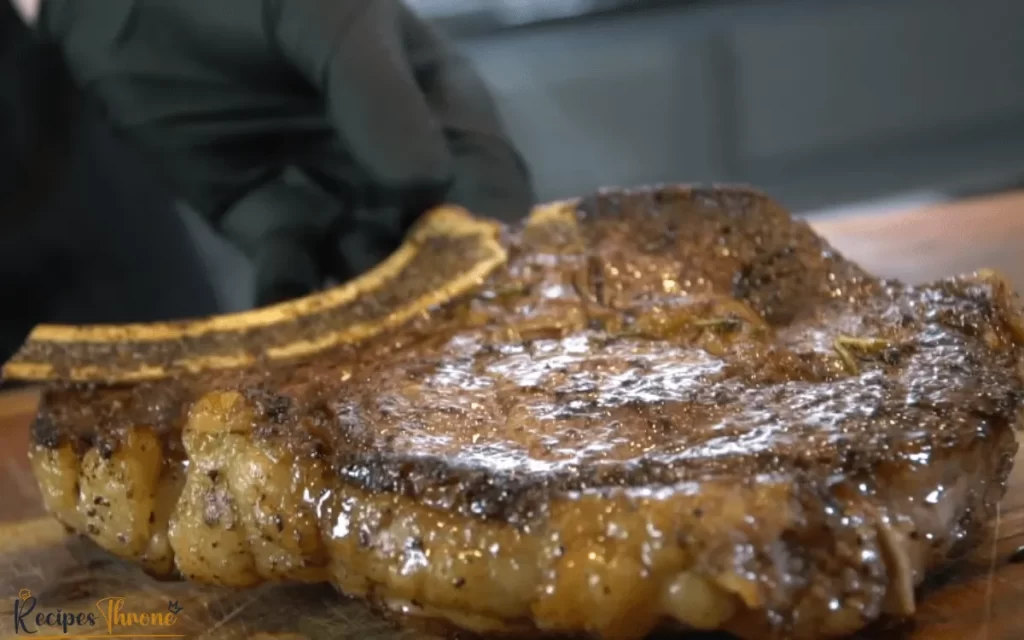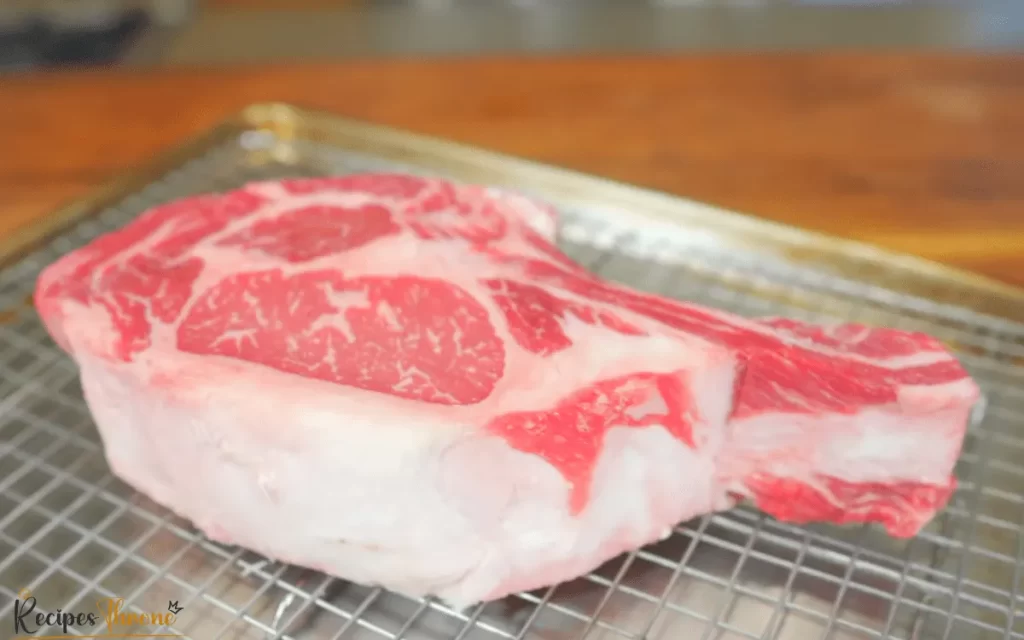Cooking a Bone in Ribeye steak is a culinary skill that transforms a simple meal into a luxurious dining experience. This meat cut, often called cowboy steak or tomahawk steak, is prized for its exceptional flavor and tender texture. The bone running through the steak contributes to its juiciness, creating an unforgettable taste. Whether preparing a special dinner or simply indulging in a quality meal, mastering the art of cooking this steak is worth the effort.

What Makes Bone in Ribeye Special?
The Bone in Ribeye stands out among steak cuts due to its rich marbling. This marbling, the fat interwoven into the meat, melts as the steak cooks, adding depth and flavor. The bone acts as a natural insulator, helping the meat near the bone retain moisture and cook evenly. As a result, every bite is tender and bursting with flavor.
Selecting the Perfect Bone in Ribeye Steak
Choosing the right Bone in Ribeye steak is the first step to success. Look for these qualities when selecting your steak:
- Marbling: Aim for evenly distributed fat throughout the meat. More marbling typically means more flavor.
- Thickness: A steak at least one inch thick ensures even cooking. Thicker cuts also offer greater flexibility in achieving the desired doneness.
- Source: Opt for high-quality beef from trusted butchers or specialty stores. Angus or Wagyu beef are excellent choices for their superior tenderness and taste.
Why Bring the Steak to Room Temperature?
Before cooking, rest the bone-in Ribeye steak on the counter for about 30 minutes to allow it to reach room temperature. This simple step ensures the steak cooks evenly, preventing the outside from overcooking while the inside remains underdone.
Seasoning Your Bone in Ribeye
Seasoning is crucial to enhancing the natural flavors of your steak. A sprinkle of flaky sea salt on both sides is often all you need. Avoid using black pepper before cooking, as it can burn at high heat. Instead, add it after cooking for a burst of flavor.
Cooking Methods for Bone in Ribeye Steak
There are several techniques for cooking a Bone in Ribeye. Each method offers unique advantages, depending on your preference and available tools.
1. Skillet-to-Oven Method
This approach is a favorite among chefs. This method uses the intense heat of a skillet to create a flavorful sear, followed by the consistent heat of an oven to ensure the steak cooks evenly.
2. Grilling
Grilling is ideal for outdoor cooking enthusiasts. This approach adds a smoky aroma that complements the steak’s robust flavor.
3. Broiling
Broiling uses the oven’s sole’s direct heat to cook the steak, producing a beautifully charred crust while preserving its juicy interior.
Step-by-Step Guide to Cooking Bone in Ribeye
Cooking a Bone in Ribeye to perfection requires attention to detail. Here are the steps for a reliable and effective process:
- Preheat the Skillet
- Place a cast-iron skillet on the stovetop over medium-high heat. Ensure the skillet is hot before adding oil to prevent sticking.
- Sear the Steak
- Pour a small amount of olive oil into the skillet, place the steak inside, and let it sear for 3–4 minutes without turning. This step forms a golden-brown crust that locks in flavor.
- Add Aromatics and Butter
- Toss garlic cloves, fresh rosemary, and thyme in the skillet. Add a generous amount of butter and allow it to melt. Use a spoon to coat the steak with the rich, flavorful mixture.
- Finish in the Oven
- Transfer the skillet to a preheated oven set at 350°F. For medium-rare, cook the steak for 5–7 minutes, adjusting the time for your desired doneness.
- Rest the Steak
- Take the steak out of the oven and rest for 10 minutes. This helps the juices redistribute, ensuring the meat is tender and flavorful.

How to Check for Doneness
Achieving the perfect level of doneness requires precision. Use a meat thermometer for accuracy:
- Rare: 120–125°F
- Medium Rare: 130–135°F
- Medium: 140–145°F
Alternatively, you can use the finger test, comparing the steak’s firmness to the pad of your thumb when pressing different fingers together.
explore our Enchiladas Potosinas Recipe: A Spicy Mexican Delight to complete your meal.
Common Mistakes to Avoid
Cooking a Bone in Ribeye can be intimidating, but avoiding these mistakes ensures success:
- Skipping the Resting Time: Resting is essential to lock in the juices.
- Pressing the Steak: Never press the steak with a spatula, as it releases precious juices.
- Using a Cold Pan: A hot skillet is crucial for a proper sear.
Pairing Bone-in Ribeye with Sides
A well-prepared Bone in Ribeye deserves equally impressive side dishes. Consider these options for a complete meal:
- Garlic Mashed Potatoes: Smooth and flavorful, they perfectly balance the steak’s richness.
- Sautéed Green Beans: Light and crisp, they provide a refreshing contrast.
- Roasted Vegetables: Caramelized carrots, onions, and Brussels sprouts add depth to the meal.
Learn the best tips for roasting vegetables
Adding Sauces to Enhance Flavor
While the Bone in Ribeye is delicious on its own, adding a sauce can elevate its profile:
- Classic Béarnaise Sauce: Rich and buttery, with a hint of tarragon.
- Peppercorn Sauce: A creamy, spicy accompaniment that pairs beautifully with ribeye.
- Garlic Herb Butter: Simple yet indulgent, it enhances the steak’s natural flavors.
Creative Ideas for Leftovers
Leftover Bone in Ribeye can transform into delicious new meals. Here are some ideas:
- Steak Salad: Slice thinly and toss with mixed greens, cherry tomatoes, and a balsamic glaze.
- Steak Tacos: Pair with guacamole, salsa, and warm tortillas for a quick lunch.
- Steak Sandwich: Layer on crusty bread with arugula, caramelized onions, and horseradish mayo.
How to Reheat Leftover Ribeye
Reheating a steak without losing its quality is an art. Avoid using a microwave, which can make the meat rubbery. Instead:
- Heat a skillet over medium heat with a small amount of oil.
- Slice the steak into thin pieces for quicker reheating.
- Sear each side lightly to warm through without overcooking.
Expert Tips for Cooking Bone in Ribeye
Cooking the perfect Bone in Ribeye involves small but significant details:
- Always pat the steak dry before cooking to ensure a crisp sear.
- Use fresh herbs like rosemary and thyme to enhance the natural flavors.
- Baste with butter during cooking to achieve a rich, savory taste.
Conclusion
Cooking a Bone in Ribeye steak is a rewarding experience that delivers restaurant-quality results at home. By selecting the proper cut, mastering the cooking techniques, and pairing it with complementary sides, you can create a satisfying and memorable meal. Remember, attention to detail is the key to achieving perfection. With this guide, you’re heading to becoming a ribeye expert.
